Cypripedium
in China
|
Dr.
Holger Perner
is graduated as Diplom-Biologe (master degree in plant ecology)
in 1991 and PhD (ecology) in 1996.
Until 2001 researcher and scientific editor in a German national
research center.
Born in Hamburg, Germany, since 2001 working for the Huanglong
Nature reserve, Sichuan, China.
|
|
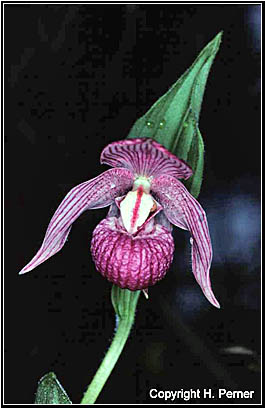 Cypripedium
yunnanense
Cypripedium
yunnanense |
ON: How long are
you studying orchids and specially Cypripedium?
HP: My interest in orchids goes back to my childhood
and the interest in slipper orchids aroused early. I was hooked to cypripediums
when our neighbor, my schoolteacher, showed me a color painting of Cypripedium
calceolus, native
to the mountains of central and southern Germany. I was about 8 years
old at that time and it took me several years before I could see my
first Cypripedium in flower in the wild. Oddly enough it was
not in Europe but in Manitoba, Canada, where I was stationed for some
weeks during my military service. Since 1984 I cultivate cypripediums,
some ten years after I started to cultivate tropical orchids. Scientifically
I study cypripediums since my days at the university. My interest in
Orchids stretches over more than just the slipper orchids and I have
a keen interest in genera like Pleione (another genus mostly
at home in China), Cymbidium and Dendrobium , to mention
just a few. But admittedly the slipper orchids are always top on my
list ...
ON: How many species does this genus have?
HP: The genus comprises of 45 species.
ON: Which is its geographical distribution?
HP: Cypripediums are confined to the northern
hemisphere where they mainly grow in the boreal regions as well as temperate
mountain forests in Europe, Asia and North America. Few species occur
in subtropical regions of northern
central America and southeast Tibet.
ON: Which is or are the most wide spread species?
HP: The most widespread species is Cypripedium
guttatum, which can be found in northeastern Europe, northern Asia,
southwest China, Japan and northwest North America. Cyp. calceolus
is not occurring in North America and thus not a circumpolar species
like Cyp. guttatum. The North American yellow slipper orchids
only superficially resemble the Eurasian Cyp. calceolus by color
and overall shape but have distinct morphological characters and belong
to another species, Cyp. parviflorum, which comprises of 3 varieties.
ON: China seems to be one of the richest countries on species of Cypripedium,
how many occur there?
HP: No other country in the world hosts so many
slipper orchids than China does. 21 species of Paphiopedilum and
32 species of Cypripedium grow within its boundaries.
ON: Which are the Chinese endemic species?
HP: Endemic to China are 20 Cypripedium species:
Cyp. subtropicum, Cyp. flavum, Cyp. henryi, Cyp. segawai, Cyp. fasciolatum,
Cyp. farreri, Cyp. franchetii, Cyp. calcicolum, Cyp. yunnanense, Cyp.
ludlowii, Cyp. palangshanense, Cyp. plectrochilum, Cyp. formosanum,
Cyp. margaritaceum, Cyp. fargesii, Cyp. sichuanense, Cyp. lichiangense,
Cyp. forrestii, Cyp. micranthum and Cyp. bardolphianum. Cyp.
wardii is also known from Northern Burma and Cyp. lentiginosum
from Southeast Yunnan most likely occurs also south of the border in
northern Vietnam.
ON : Which are the characteristics of their habitat?
HP: Most Chinese cypripediums occur in open shrub
and open woodland at altitudes between 2000 and 3600 m on limestone
within a layer of friable soil with a mesic moisture regime. Few grow
in more shady situations in dense shrub,
like Cyp. debile and Cyp. sichuanense. Cyp. tibeticum
on the other hand can be often found in alpine meadows fully exposed
to the sun. However, during the growing period in summer the monsoon
often brings cloudy weather. And
it is also the climate in southwestern China, the home of 27 of the
32 Chinese species, that perhaps forms the most characteristic element
in the set of growing conditions. During the main growing season in
summer the weather
in the mountains is relatively cool, often overcast and rainfalls are
frequent. Towards autumn it becomes sunnier and drier, often with slightly
higher day temperatures but cooler nights. When the first severe frosts
set in around
late September and early October the cypripediums shed their seeds and
the leaves start to whither. Winter starts in November and is often
sunny and usually rather dry and constantly cold. Warm-spells during
winter are
almost unknown and snowfall only becomes more frequent towards the end
of the
winter in March.
ON: In your lecture, you said that the interest in cultivating this
genus has been increasing in the last decade. All of them should be
cultivated under temperate conditions?
HP: Yes. The few warm-temperate to subtropical
species from Mexico to Guatemala are nearly impossible to be kept alive
in cultivation and Cyp. subtropicum from southeastern Tibet has
never been tried in cultivation. All other
species are temperate to cool-temperate species. With some tricks, however,
they can be grown even in warmer regions. One is to grow them under
lights in pots filled with an inert mix of clay pebbles, pumice perlite
and
perhaps a little fine bark or shredded tree fern (80-90 % mineral and
10-20 % organic compounds) in an air-conditioned room with day temperatures
around 20 °C and a night drop of 5 °C or so. The relation humidity
should lie around 70 %. Towards the end of the growing season (some
5-6 month after emerging of the leaves) the day temperature should be
as low as 10-15 °C and with the leaves dropping the plants can be
put into hibernation (within their pots) by placing them in a fridge
at constant lows around 4 °C. They shouldn't have temperatures above
8 °C for at least 8-12 weeks and shouldn't freeze either. In Japan
I saw a successful cypripedium culture in a suburban of Tokyo. It was
July, the temperature rarely fell below 30 °C even at night and
the humidity was very high. Still several types of cypripediums (species
from Eastern Asia like Cyp. macranthos as well as North American
species and
several horticultural hybrids) were thriving in none-glazed ceramic
pots filled with a substrate consisting mainly of coir (shredded coconut
hulls and cut fibers) with a little fine charcoal added. The moisture
evaporating through the pot's walls kept the roots cool enough to grow.
While the mentioned types of cypripediums looked healthy and happy,
the few species from Southwest China I saw in Tokyo weren't doing well.
They seem to prefer overall cooler growing conditions which can easily
be match with in higher regions in the mountain areas of Japan, in most
of Europe and North America and certainly also in cooler regions in
the southern hemisphere.
ON: Is it very hard to cultivate them? What kind of care the grower
should give?
HP: Under temperate conditions cultivating cypripediums
is not too difficult. In China I work with a mix often used by North
American growers too: Perlite with some organic matter added. The composition
is 80-90 % Perlite, the
rest turf soil from alpine meadows which is not unlike peat moss with
a little soil, i.e. clay particles added; this turf soil is commonly
sold in Sichuan as potting material for all kinds of plants. As it is
rather acidic, pH 3.5 to 4, I add a little calcium hydroxide powder
to neutralize the humic acids in the turf soil and mix it subsequently
with the perlite. I water with regular tap water and fertilize every
other week with a quarter strength all purpose fertilizer (NPK 20:20:20
with trace elements) during the growing season. During the dormant season
in winter, when the growth above soil
has died down and the cypripediums are hibernating as rhizomes with
fully intact root system and underground buds for the next years growth
(thus they have to be left undisturbed in the pot!) the substrate has
to be kept just slightly moist but never wet and the temperature should
never be higher than 8 to 10 °C for at least three months. Generally
slugs and snails are the most important pest on cypripediums of which
the grower has to take care of.
ON: How many species and genera of orchids occur in China?
HP: China has about 1300 orchid species in approx.
180 genera and several species and some genera are endemic, like e.g.
Changnienia amoena or Nothodoritis zhejiangensis.
ON: Thank you, Dr. Holger Perner.
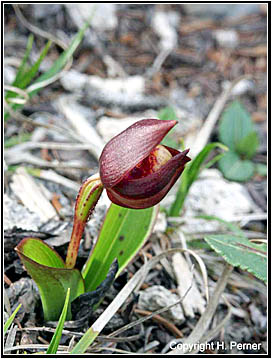
Cypripedium bardolphianum |
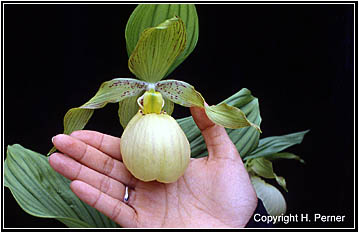
Cypripedium fasciolatum |

Cypripedium flavum and tibeticum |

Cypripedium henryi |
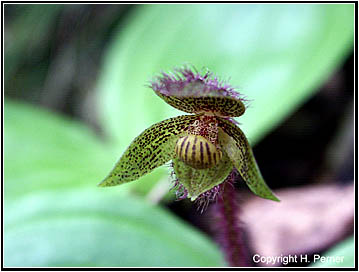
Cypripedium micranthum |

Cypripedium palangshanense |
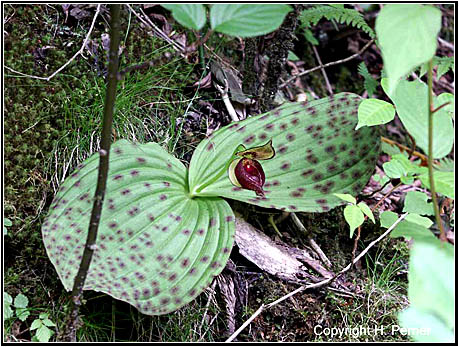
Cypripedium sichuanense |
Photos
by H.Perner
|
Any
kind of reproduction (print, digital or anyone other) of any
type of material of this site - texts, layout, photos, images
and others - is strictly forbidden without previous written
permission by the authors.
|

|